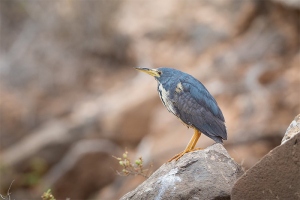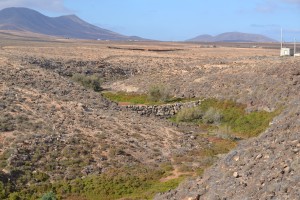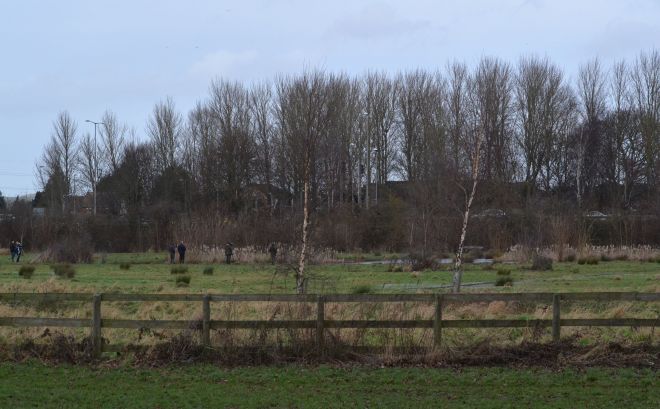Yes really! Though this is a little further than my oft-cited preferred twitching range it was something that just had to be done. I feel in the mood for madcap adventure at present and the scenario that is about to be described ticks all the boxes. Since the start of December a Dwarf Bittern has been frequenting a Barranco (river valley) quite near Rosario airport on the Canary Island of Fuerteventura. After viewing the picture (below) on RBA my reaction was I would rather like to see this bird and so on a whim I checked air fares. At the head of the results list were return flights for just £65 provided I went out and back this weekend.

Dwarf Bittern (public domain © David Perez)
I next sounded out company but with the usual sort of complexities over matching schedules. Sometimes you just have to get up and go and this seemed like one such instance. When I then found a last minute apartment for £37 everything about this escapade was beckoning hard. So I upped and went.
Dwarf Bittern, one of the world’s smallest herons, normally occurs in much of non-arid Africa south of the Sahara but is uncommon throughout its range. It is a migratory species north and south within the tropical and sub-tropical zones and can wander further including the Canary Islands and southern France. But this particular bird is only the fifth recorded individual to have crossed the dividing line between the Afrotopical and Western Palearctic bird regions.
The outward journey was completed without a hitch and I arrived in Fuerteventura at around 1:30pm. This was my second visit here, the first being a five-day stay in February 2015 (see trip reports). After collecting my hire car I needed to drive around a bit to charge up my dodgy sat nav, but after a not too arduous diversion it got me to the GPS location (pictured below, left) cited on RBA. While looking for this site I encountered 10-12 Egyptian Vulture circling over a waste recycling plant. The latter is a raptor I have still seen only on this island of Fuerteventura.

The Bittern location

Don’t tell Hertz
The stretch of Barranco de Rio Cabras in question was set back from a minor road but I drove right out to the exact GPS N28.4758′ W13.9030′ across stony ground (above, right). I was soon joined by two Swedish birders who had parked back on the road. We scanned up and down the shallow gorge of the barranco, in which there were two dams with a lagoon in between, but there was no sign of the bird. Bitterns do after all spend much of their time keeping out of sight, so why should this one be any different? After 40 minutes or so we were joined by two groups of English birders, one of which had seen the bird here earlier in the day, while the other came in on a later flight than my own.
All of the Brits had like myself travelled here just to connect with the Dwarf Bittern, also taking advantage of exceptionally low air fares on this last weekend before the Christmas holiday season. These people sounded like they knew where to look and I followed them down into the barranco, but soon began to feel uncomfortable. Their tactics were none too subtle and they seemed intent on flushing the bird that eventually flew downstream over all our heads and disappeared into cover not to re-emerge. So everybody had now seen the bird, if briefly.

Barranco de Rio Cabras at GPS N28.4758′ W13.9030′
My overnight accommodation at Apartamentos la Piramide in Costa Antigua was superb, a self-contained apartment in a poolside setting. The cheap and cheerful, as much as you like for €10 restaurant here catered for my sustenance needs. This struck me as a good base should I bird again solo in Fuerteventura, since the apartments are also fully self-catering but in a sociable ambience, and shops are nearby. This situation was far superior to the poorly furnished and dingy “studio apartment” in a rather tacky hotel that was my base for the 2015 trip.
I slept little though and so set off at 6am on Sunday morning, as planned to drive to El Cotillo plain at the north-west corner of the island hoping to find that special Fuerteventura resident Houbara Bustard. Daybreak found me heading out along the dirt road I had travelled twice in 2015, seeing one Houbara each time though rather distantly. This time I drove a little further south than previously, encountering virtually no birds at all other than a few Raven. Turning round after the sun had risen I hoped for better fortunes on the return drive.

Houbara Bustard (male)
At exactly the spot I was briefed on prior to that 2015 visit as the prime location for Houbaras here, I gained my prize. Having checked many likely looking objects in the middle distance up until this point, there suddenly was a backlit and beautiful Houbara Bustard of the offshore race staring straight back at me. I stopped the car, turned off the engine, stayed inside, reached for the camera and this bird remained completely unconcerned. It appeared to be warming up in the early morning sunshine, looking about itself and preening at intervals. What an absolute stunner! Eventually my willing subject began to peck whatever it eats from the surrounding shrubs, wandering away as it did so. And hence, mindful of the advancing time I moved on to a renewed appointment with the Dwarf Bittern 23 miles away.
Back on site, one of the groups of British birders was again down in the Barranco. When they got near I learned they had searched all over but found nothing yet. I elected to remain on the cliff top from where on this warm and pleasant morning a roll call of Fuerteventura bird life presented itself. White Wagtail, Chiffchaff and Berthelot’s Pipit were foraging on the rock faces, while Fuerteventura Chat and rather striking African Blue Tit came and went. Four Black-winged Stilt were present on the lagoon, a flock of Trumpeter Finch buzzed past, a pair of Ruddy Shelduck announced themselves overhead, and the kronking of Raven filled the air. This was all excellent entertainment but of the star visitor there remained no sign.
Then after about an hour, as if out of nowhere there was another fly past and the Dwarf Bittern settled on the rock face on my side a little upstream from where I was perched. The three birders on the opposite side of the gorge could all see it, but I stood no chance from my position. If this bird had been skulking hitherto it was suddenly well and truly out in the open. But everything else about this excursion had seemed meant so far, and so was this.

The barranco looking downstream

The upper dam
As I walked upstream along the cliff top the bird relocated again into the greenery just to one side of and in front of the second dam (pictured above, right). I was able to cross the gorge behind the dam where the river bed is dry, then move along the bottom of the opposite rock face back to the dam itself. That was where the collective experiences of this trip went off the top of the scale. The bird commenced to climb the opposite wall of the barranco, sometimes through the covering of green vegetation but often across the surface. Then it moved back downward again eventually to emerge at the water’s edge, behaving at all times in a very Bittern like way before eventually heading downstream once more.
This bird is an adult male, having dark blue-grey upperparts and upper wings with elongated head and tail feathers. The throat and upper breast are streaked pale buff darkening to tawny on the lower abdomen. The bill and legs are predominantly yellow. Dwarf Bittern are 25 to 30cm in length, with an average wingspan of 45 to 50cm. More than one source I researched said they are most often encountered when relocating or flying into cover, so to observe this one foraging openly was simply superb. Numbers of other birders have told of similar experiences at this site though, and this bird has most reliably been seen usually around the middle of the day between 11am and 2pm.

Dwarf Bittern (adult male)
These (above and below) are my results

Dwarf Bittern (adult male)
Everything so far on this escapade had gone just perfectly, but when I got back to the airport a four hour delay was announced on my return flight due to severe weather at home. When the outward flight arrived there was an attempt to turn it around quickly but no-one was allowed on board. People like to malign Ryanair but they boast the fewest delays and their flight to Leeds Bradford got away just an hour late. The issue with my Jet2.com flight was that the pilot had already worked his regulation flying hours. People were wondering why this airline didn’t know that when the flight left Stansted. I suppose low prices mean low overheads, as I tell moaners in the queues at Lidl, so maybe Jet2.com doesn’t have stand by crews.
Anyway I’m British so there’s no point making a fuss. Overnight accommodation was arranged quickly and efficiently, and the passengers were all put up at a large 4-star hotel in Caleta del Fuste with dinner and breakfast on the airline. After all the soup wagon might not make it out to my park home estate in severe weather, and I would not now be getting back to blighty in the middle of a freezing night after such a long day.
The return journey went perfectly smoothly and the captain’s explanation of the previous day’s events was quite plausible, allowing for a certain amount of PR. The Jet2.com staff were all very pleasant and friendly throughout the unwanted part of this scenario. I eventually got home in the early evening of Monday after a weekend that will dwell in my memory for a long time to come. This was quite simply one of the best things I have ever done.






















